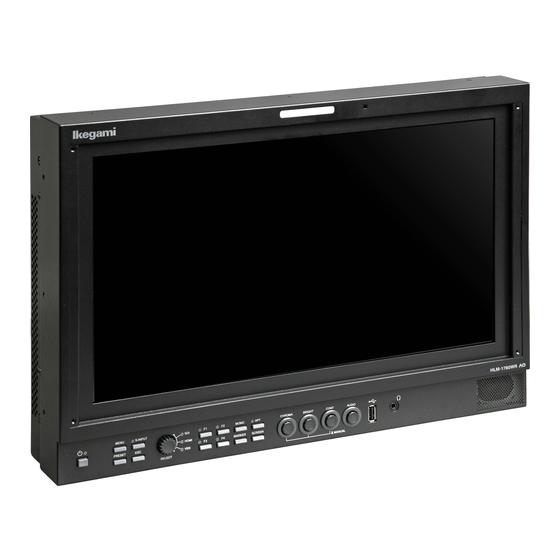
Summarization of Contents
IMPORTANT SAFETY INSTRUCTIONS
1. General
General safety guidelines for operating the monitor.
2. Power supply
Guidelines for safe use of power sources and grounding.
3. Usage and location
Recommendations for safe placement and environmental conditions.
4. Cleaning
Instructions for safe cleaning procedures to avoid damage.
5. Repair
Conditions requiring professional servicing and safety precautions.
Cautions for Rack-Mount
Safety considerations specific to rack-mounted installations.
Precautions Upon Use
1. Power Supply and Shock Prevention
Prohibits non-specified power and advises against physical shocks to the monitor.
2. Environmental and Storage Precautions
Advises against extreme temperatures, humidity, sunlight, and corrosive environments.
3. Panel Surface and Liquid Crystal Handling
Provides guidance on handling the screen surface and dealing with liquid crystal leaks.
4. Continuous Display Caution
Warns about potential issues with prolonged display of static or bright images.
5. Critical Application Restrictions
Lists applications where the monitor should not be used due to safety implications.
Monitor Overview and Features
1-1. Outline
General description of the monitor models and their intended use.
1-2. Features
Highlights key features like LCD panel, multi-format support, and input sources.
Names of Parts and Functions
2-1. Front Control Panel
Identifies and explains the controls on the front of the monitor.
2-2. Rear Panel (Left)
Details the connectors and components on the left side of the rear panel.
2-3. Rear Panel (Video Inputs/Outputs)
Explains the various video input and output connectors on the rear panel.
2-4. External Control
Illustrates methods for controlling the monitor externally via various interfaces.
Markers and Menu Functions
3-1. Types of Markers
Describes the different types of on-screen markers available for display adjustments.
4-1. MENU Outline
Provides an overview of the monitor's menu structure and navigation.
4-2. Description of MENU-INPUT Functions
Details settings related to input signal selection and configuration.
4-3. Description of MENU-VIDEO Functions
Explains video-related settings such as chroma, scan mode, and aspect ratio.
4-4. Description of MENU AUDIO Functions
Covers audio settings for embedded and analog sources, speaker output, and level meters.
4-5. Description of MENU-TC/WFM/SC Functions
Describes settings for Time Code, Waveform Monitor, and Vectorscope displays.
4-6. Description of MENU-MARKER Functions
Details settings for various marker types and their display properties.
4-7. Description of USER MARKER Functions
Explains how to create and customize user-defined markers.
4-8. Description of MENU-CAPTURE Functions
Covers functions for capturing images and using split-screen display modes.
4-9. Description of MENU-UTILITY Functions
Explains utility settings like OSD transparency, tally display, and system lock.
4-10. Description of MENU-FUNC.SW Functions
Details how to assign functions to the front panel's function switches.
4-11. Description of MENU-P.REMOTE Functions
Explains settings for parallel remote control and pin assignments.
4-12. Description of MENU-UMD/IMD Functions
Covers settings for User/Monitor Display (UMD/IMD) with TSL or user input.
4-13. Description of MENU-USB MEMORY Functions
Explains how to manage files and firmware updates using USB memory.
4-14. Description of MENU-C.CAPTION Functions
Details settings for Closed Caption display in HD and SD signals.
4-15. Description of MENU-NETWORK Functions
Covers network settings such as IP address and speed duplex for remote control.
4-16. Description of MENU-RESET Functions
Explains how to reset monitor settings to default or specific files.
4-17. Description of MENU-INFO Functions
Shows how to display system information like model name, firmware version, and settings.
Preset and Mouse Menu Operations
5-1. List of preset menu
Lists the available preset menu files and explains how to select and change them.
6-1. Basic procedure of the mouse menu
Explains the basic behavior and functions of the mouse when used for menu navigation.
6-2. Basic procedures on the MENU and PRESET MENU screens
Details how to use the mouse for navigating and modifying settings in the MENU and PRESET screens.
Specifications, Remote Control, and Options
7-1. General specifications
Provides overall technical specifications for power, dimensions, and environmental conditions.
7-2. Rated performance
Details the performance characteristics of SDI, embedded audio, analog composite, and HDMI signals.
7-3. Specifications for LCD Panel
Lists specifications for the LCD panel, including pixel count, size, brightness, and viewing angle.
7-4. Functions
Summarizes the front panel operations and available functions.
7-5. Remote Control
Explains the different remote control options available for the monitor.
8. Mounting
Describes methods for physically mounting the monitor, including rack adapters.
9. Options
Lists optional accessories and mounting hardware available for the monitors.
External Views and Dimensions
10-1. HLM-960WR
Provides dimensional drawings and external views of the HLM-960WR model.
10-2. HLM-1760WR
Provides dimensional drawings and external views of the HLM-1760WR model.
10-3. HLM-2460W
Provides dimensional drawings and external views of the HLM-2460W model.
Technical Data and Pin Functions
Data 1 PC Input Signal Compatible Formats
Table listing compatible PC input signal formats with frequency specifications.
Data 2 Parallel Remote Pin Functions
Details the pin assignments and functions for parallel remote control.
Data 3 RS-485 Pin Functions
Explains the pin functions for RS-485 serial communication.
Data4 Control with Remote Controller
Compares the control capabilities of serial and wireless remote controllers.















Need help?
Do you have a question about the HLM-1760WR and is the answer not in the manual?
Questions and answers